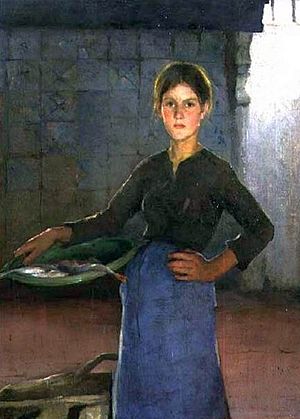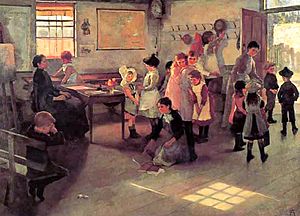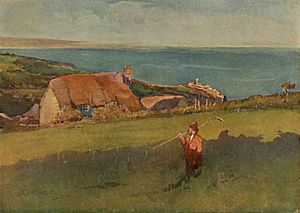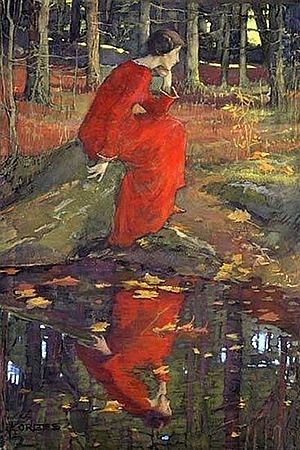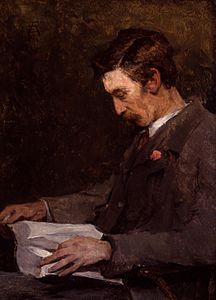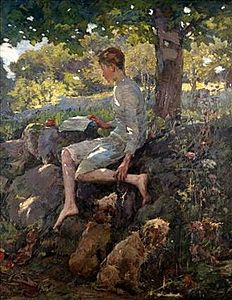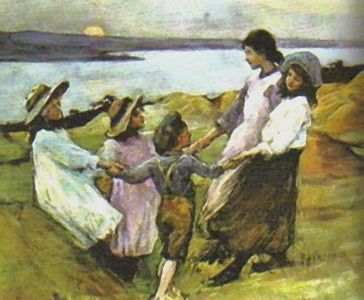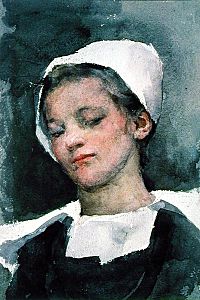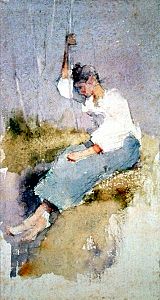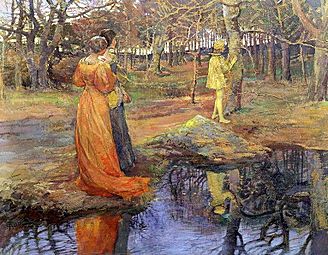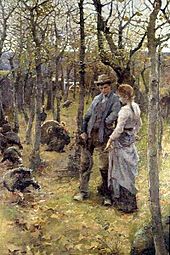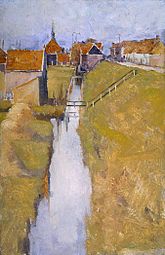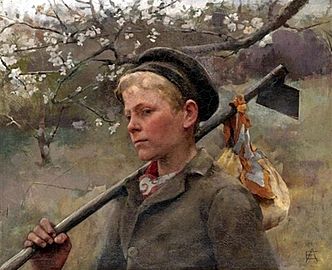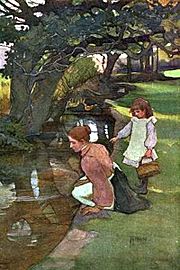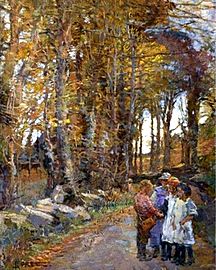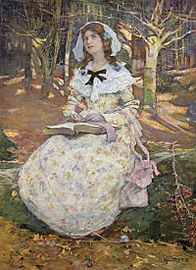Elizabeth Forbes (artist) facts for kids
Quick facts for kids
Elizabeth Forbes
|
|
|---|---|
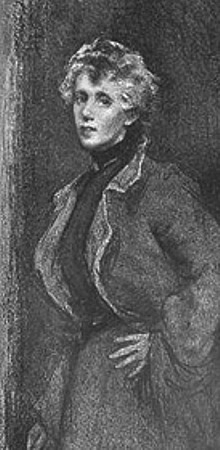
Self-portrait about 1900
|
|
| Born |
Elizabeth Armstrong
29 December 1859 Kingston, Ontario, Canada
|
| Died | 16 March 1912 (aged 52) Newlyn, England
|
| Nationality | Canadian-English |
| Education | South Kensington Art School |
| Known for | Painter |
| Movement | Newlyn School |
| Spouse(s) | Stanhope Forbes |
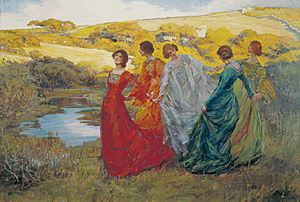
Elizabeth Adela Forbes (born Elizabeth Armstrong; 29 December 1859 – 16 March 1912) was a talented Canadian painter. She spent most of her career in the United Kingdom. Elizabeth Forbes was famous for painting pictures of children. Her painting School Is Out is one of her most well-known works. She was friends with famous artists like James Abbott McNeill Whistler and Walter Sickert. Their styles influenced her art, especially her etchings.
After studying art in Europe, Forbes settled in Newlyn, England. There, she raised her son and started an art school with her husband, Stanhope Forbes. Her paintings were shown in important art shows, and she won awards for them. Today, her artworks can be seen in museums in Canada, the United States, and England.
Contents
About Elizabeth's Life
Elizabeth Armstrong was born in Kingston, Ontario, Canada. She was the youngest child of William Armstrong, who worked for the Canadian government. Elizabeth was taught at home in Canada. Later, she went to England to study art with her mother. Her father passed away shortly after she left for England. She and her mother then lived with an uncle in Chelsea, London.
In 1889, she married Newlyn School painter Stanhope Forbes. Their son, Alec, was born in 1893. In 1904, Elizabeth and Stanhope moved into a house they designed themselves called Higher Faugan.
Elizabeth Forbes passed away in 1912. People called her "the Queen of Newlyn" because she helped the art community there so much.
Her Art Education
As a young girl, Elizabeth Armstrong traveled to England with her mother. She studied art at the South Kensington Art School. After returning to Canada for a short time, she went to the Art Students League of New York. Her teacher, William Merritt Chase, told her to study in Munich, Germany. She followed his advice and learned from artists J. Frank Currier and Frank Duveneck in the early 1880s.
Elizabeth's Art Career
Starting Her Art Journey
In 1882, Elizabeth explored plein air painting. This means painting outdoors, directly from nature. She did this at an artists' colony in Pont-Aven in Brittany, France. She also taught etching there. While in Brittany, she sent her paintings to London to be sold. All of them sold on the very first day of the show!
The next year, she worked in London as a printmaker. She joined the Society of Painter Etchers. In the summer of 1884, she studied near Haarlem in Zandvoort, the Netherlands, with her former teacher William Merritt Chase.
Elizabeth used oil paints, watercolors, and pastels. She also made etchings. Her art often showed children, landscapes, and fishing scenes. Her works were shown in important places in London, like the Royal Institute of Painters in Water Colours and the Royal Academy. Some of her etchings were collected by her mentor, Mortimer Menpes. These etchings showed the influence of artists like James Abbott McNeill Whistler and Walter Sickert.
Life and Art in Cornwall
In 1885, Elizabeth and her mother moved to Newlyn, Cornwall, England. She set up her art studio in Newlyn. She won a medal at the Paris International Exhibition in 1891. She also won a gold medal for an oil painting at the World's Columbian Exposition in Chicago in 1893. Between 1893 and 1899, her art was shown in over 63 exhibitions in London.
After Newlyn, Elizabeth lived in St. Ives. There, she met Stanhope Forbes, and they married in 1889. Even after getting married, Elizabeth continued to be a very active and successful artist. This was not always common for women at that time.
In 1899, she and her husband Stanhope Forbes opened the Newlyn Art School. They also helped create and support the Passmore Edwards Art Gallery in Newlyn, now known as the Newlyn Art Gallery (NAG). Elizabeth's paintings, many of which featured children (including her son Alec), were inspired by French realism. She was a very successful artist, even more so than some male artists of her time. She became well-known across the country and is closely linked with the Newlyn School of artists.
The artists of Newlyn were popular because they painted everyday life scenes. They showed a positive and traditional view of country life. This appealed to people living in cities. Their paintings often showed real places and local people as models.
In 1900, Forbes had an exhibition in London called Children and Child Lore. She also wrote and illustrated a children's book for her son, Alec, called King Arthur's Wood, which came out in 1904. She started a magazine called The Paper Chase in 1908. In 1910, she won an award at the Royal British Colonial Society of Artists Exhibition.
After she passed away, her works were shown in important exhibitions. These included "Four Centuries of Women’s Art" in 1990-1991. A special show of her works, called "Singing from the Walls: The life and work of Elizabeth Forbes," was held in 2000.
Famous Works
Some of Elizabeth Forbes's well-known paintings include:
- A Dream Princess, 1897, at the Royal Cornwall Museum
- School is Out, 1889, at the Penlee Museum
- The Minuet, at the Penlee Museum
- Zandvoort Fishergirl, 1884, at the Penlee Museum
Her paintings School is Out and Zandvoort Fishergirl are among her most famous.
Her artworks can be seen in many museums. These include the National Gallery of Canada, the National Museum of Women in the Arts in Washington, D.C., the Victoria and Albert Museum, and other museums in Liverpool, London, and Manchester.
Gallery
See also
 In Spanish: Elizabeth Forbes para niños
In Spanish: Elizabeth Forbes para niños


